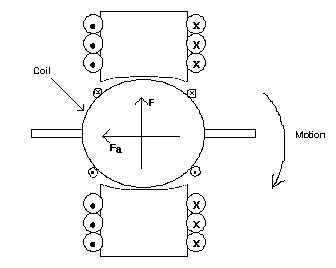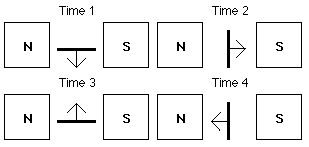
DC motors use a rotating armature to operate with a terminal voltage and constant current. The armature is a rotating coil of wire with a current running through it. Motion is produced by the changing or switching of polarities of the voltage and thereby changing the poles of the magnetic field.. This is achieved through the use of a mechanical switch or commutator.
The difficulty with motors is that the relative motion between the two magnetic fields will generate a force counter to the direction of motion due to generator action. This force is known as Counter Electro-Motive Force (CEMF)
The image to the right is a basic DC electric motor that uses electro-magnets as the poles. The Johnson motor uses permanent magnets for the stator or stationary part of the motor.


Nolan, Peter, J. , Fundamentals of College Physics,Wm. C. Brown Communications, Inc. Dubuque IA 1995
Hanselman, Duane, C. , Brushless Permanent-Magnet Motor Design, McGraw-Hill, NY,NY 1994
Beaty, H. Wayne & Kirtley, James,L., Jr, Electric Motor Handbook, McGraw-Hill, NY,NY, 1998
Subrahmanyam, Vedam, Electric Drives
Concepts and Applications, McGraw-Hill, NY,NY, 1994
http://freeweb.pdq.net/headstrong/Cat.htm
http://www.cocc.edu/~bemerson/classes/202labs/202lab7.html
http://ippex.pppl.gov/ippex/module_4/
http://howstuffworks.com/inside-motor.htm
http://trc.ucdavis.edu/Coursepages/EXCITES/activities/ccm.html
http://fly.hiwaay.net/~palmer/motor.html
http://www.mtsu.edu/~pdlee/public2_html/motor1u.html
http://www.yale.edu/prgsmart/resources/curricula/electricity.html